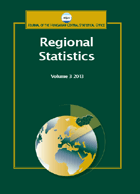Structural and administrative implications of
the Trianon Peace Treaty, 1920
Structural and administrative implications of
the Trianon Peace Treaty, 1920
Author(s): Zoltán HajdúSubject(s): Social Sciences, Economy, Geography, Regional studies, Interwar Period (1920 - 1939)
Published by: Központi Statisztikai Hivatal
Keywords: World War I; Austro-Hungarian Monarchy; Kingdom of Hungary; territorial disintegration; multi-ethnic successor states; Trianon Peace Treaty; public administration in the Kingdom of Hungary; distorted
Summary/Abstract: World War I re-organised European power and territorial relations. The victors (Entente member countries) emerged from the war with significant territorial gains, while the losers (Central Powers) suffered considerable losses and the Austro-Hungarian Monarchy was dissolved. The political-territorial power structure of the Monarchy was extremely complex. The aim of this study is to present how state and territorial administrations were reorganized in the newly independent Hungary. The dissolution of the Monarchy led to the dismantling of the multi-ethnic and quasifederal state of historical Hungary. While the Hungarian government recognised the secession of Croatia-Slavonia, it firmly opposed the detachment of other territories; not withstanding, by the end of December 1918, various nationalities (Slovaks, Romanians, Serbs) had formed quasi-blocks in Hungary and proclaimed their secession. Hungary became a sovereign state after losing the majority of the territory of the Kingdom of Hungary (71.4%) and 63.5% of its population. Defeat in the war was the major factor behind the country's disintegration that neither the civil democratic revolution and transformation nor the bloody internal proletarian dictatorship were able to reverse. The Trianon Peace Treaty simply sanctioned the changes that had already taken place through international treaties and international law. The territorial administrative division of the new Hungary was completely distorted due to the truncated cross-border counties. The 1923 territorial correction was no more than an attempt to merge the truncated counties and county fragments. This study is based primarily on cartographic analysis.
Journal: Regional Statistics
- Issue Year: 10/2020
- Issue No: 01
- Page Range: 3-22
- Page Count: 20
- Language: English

